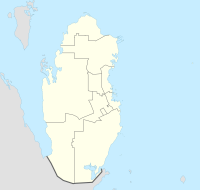Lehsain
Lehsain
لحصين | |
|---|---|
Abandoned village | |
| Coordinates: 25°32′22″N 50°56′18″E / 25.53943°N 50.93837°E | |
| Country | Qatar |
| Municipality | Al-Shahaniya |
Lehsain (Arabic: لحصين; also spelled Al-Hussayn and Al Hussain) is an abandoned village in Qatar located in the municipality of Al-Shahaniya. The area is enclosed by a dense cluster of trees. It is close to Zekreet.[1]
Archaeology
Numerous Neolithic settlements have been uncovered on Qatar's west coast in the Zekreet Peninsula and Dukhan region. During the British archaeological expedition of Qatar in 1973–74 led by Beatrice de Cardi, Neolithic-era stone cutters were found in Lehsain. They closely resemble other tools belonging to the Mousterian industry, but archaeologist G. H. Smith of the British expedition suggested that this industry could be unique to Qatar.[2]
An archaeological site dating to more recent times is Qasr Lehsain, an abandoned fort constructed to secure the local well known as Bir Lehsain.[1]
References
- ^ a b "GIS Portal". Ministry of Municipality and Environment. Retrieved 15 July 2018.
- ^ Abdul Nayeem, Muhammad (1998). Qatar Prehistory and Protohistory from the Most Ancient Times (Ca. 1,000,000 to End of B.C. Era). Hyderabad Publishers. p. 53. ISBN 9788185492049.
The stone tools from Bir Hussain comprise mainly cutters and piercers and Smith suggests (according to De Cardi, 1978:183) that they may reflect a native 'Qataran' tradition continuing the Mousterian-type industry known at Al Khor.

